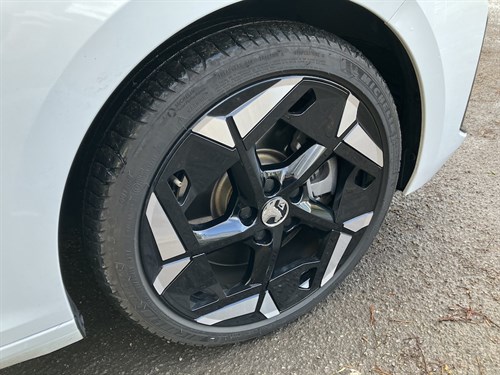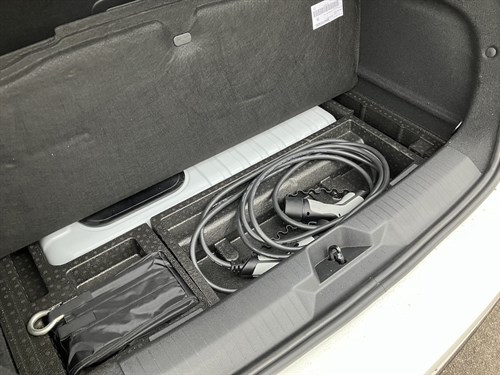We use cookies to ensure that we give you the best experience on our website. If you continue without changing your settings, we will assume that you are happy to receive all cookies on the Business Car website. However, if you would like to, you can change your cookies at any time

The start point for the best source of fleet information |
Latest report: Vauxhall Astra GSE long-term test
Date: 25 April 2024 | Author: Sean Keywood

|
|
||||||||||||
4th Report: Cause for alarm
I recently moved house, and according to long-term test cliché, this is a sure-fire cue for a report focusing on practicality and boot space. However, as it turned out, the moving process saw our Astra GSE let itself down with an unexpected annoyance.
It started during a weekend visit to my parents' house, on the final morning of which I loaded the boot with my luggage and also moving supplies, ready for the drive home later that day. A few minutes later, having returned inside, I heard a car alarm, but on checking out the window was reassured that it couldn't be the Astra as its hazard warning lights were not flashing. The alarm sounded again a couple more times during the next few minutes, during which time I was thinking that one of my parents' neighbours really needed to sort their car out, after which my dad came to inform me that, in fact, it was the Astra's alarm sounding after all. Why its lights also weren't flashing to accompany the alarm - which should happen according to the car's manual - I have no idea.

Anyway, having returned to the Astra in a state of annoyance and some embarrassment, I concluded that something must have fallen over inside to trigger the alarm, and resolved to repack it more carefully. But clearly not enough, as it went off again a couple more times before I left that evening, leading me to constantly keep an ear out for it in a slightly paranoid state, for fear of further annoying my parents' neighbours.
Having returned home, and unloaded the Astra, there were no more alarms for a few days. But then, on the day of the move itself, and with it now parked outside my new home, the alarm sounded again. By this point I'd concluded that for some reason leaving the Astra parked with a full boot was a problem, and delved into the instruction manual for a solution. Having eventually found the relevant section (overcoming the issue mentioned in a previous report of the manual's pages being printed out of order) I discovered that by holding a button on the ceiling when the ignition was turned off I could activate a mode designed for leaving a pet in the car, which would deactivate the interior sensor, and after doing this until the car was unloaded later that day, there were no more alarm soundings. At the time of writing, a couple of weeks after the move, these have yet to return, leading me to suspect my 'full boot' theory is the correct one - but why this should have been an issue, I can't explain.
Anyway, returning to my initially planned subject for this report, the Astra GSE's boot doesn't benefit from a flat load lip, but it offers a reasonably practical space, with the presence of an under-floor storage location for the EV charging cable making it slightly more so than my previous long-term Astra Ultimate, which had a storage bag for this in the main boot compartment. Also, as well as 60/40 folding rear seats there's a useful ski hatch which can be used for longer items. However, at 352 litres the boot's capacity is 70 litres down on a petrol Astra.
One other matter relating to the move - I am expecting the appearance of the Astra's white paint to improve, as unlike at my old house, with my new driveway it is no longer parked under a tree. Here's hoping that it will continue to sit there peacefully, with no more phantom alarms to potentially annoy my new neighbours.
3rd Report: Fastra?
When Vauxhall first introduced the GSE sub-brand (which it says stands for Grand Sport Electric) just over a year ago, it was clear that the middle part of that name was as important as the ending, with the intent to produce performance models since the old VXR badge had fallen by the wayside. Therefore, while fleet managers will doubtless be most interested in the efficiency aspects of our plug-in hybrid Astra GSE, drivers who choose it may well be hoping for a proper hot hatch. So, how convincing is it in this regard?
Well, on the road, the short answer is, not especially. It's not bad on a twisty road by any means - the lowered sports suspension (the GSE sits 10mm lower than a regular Astra) does a decent job minimising body roll and there's lots of grip. But the extra weight of a plug-in hybrid powertrain (the GSE is more than 300kg heavier than a GS petrol Astra) is still conspicuous, meaning the GSE can't deliver the feeling of nippiness and agility of the best hot hatches.
Speaking of the powertrain, its levels of power and torque provide sufficient acceleration to be well into at least warm hatch territory (officially 0-62mph takes 7.5 seconds). But you need to stay well on top of the gearshift paddles to ensure the eight-speed automatic gearbox is in the right gear to accelerate out of bends, with a certain degree of anticipation needed given that there is a slight delay to shifts - and, even in Sport mode, the 'box is still a bit too keen to shift up again and leave you with less power than you were expecting. It even does this under braking, which can leave you grabbing for the paddle mid-corner - not ideal given the paddles move with the turning of the steering wheel (although at least here a possible advantage of the subtle Active Sport Sound engine sound enhancement I wrote about last month emerges, making it slightly easier to hear the revs and react accordingly). The brakes, too, are rather unsatisfying to use, given the element of energy regen involved with the hybrid system.

So, all in, a driver approaching the GSE expecting an uncompromised performance machine is likely to be disappointed. However, that doesn't mean that the sporty nature of this
model doesn't have other good points. The styling, for example - having lived with it for a couple of months now, I can confirm the bodykit and fab alloys help bring a real sense of car park presence to this Astra (although the white paint is, while a striking contrast with the black roof and wheels, unsurprisingly fast to look dirty in winter).
It should also be noted that the lowered sports suspension doesn't mean much of a compromise in ride quality. It's a degree firmer than the regular Astra, but nowhere near uncomfortable, and there have been no complaints from passengers, or indeed any pining from myself for my previous Astra Ultimate test car on motorway journeys. Which means you certainly don't lose out by choosing the GSE spec - just that the associated thrills it can bring might not be as big as some drivers would hope.
2nd Report: Same difference
When we take cars on long-term test at Business Car, part of the motivation is to pick up detail we might have missed during the shorter test drives we carry out for our regular reviews. However, as it turns out, even our usual six-month long-term spells might not be enough to catch everything. This is something I've personally discovered since switching my previous Vauxhall Astra Ultimate for my current GSE test car, and discovering things I thought were new with the GSE, only to find out they were actually installed with the Ultimate also, just hadn't been switched on.
As I mentioned in my first report on the GSE last month, one of these is the Driver Welcome function, which slides the driver's seat back when the ignition is turned off with the aim of aiding exit and entry. Having investigated the car's settings, I was, as I'd hoped, able to turn this off, since it didn't provide any benefit for me personally.
Another feature that it turns out appeared on the Ultimate as well as the GSE is Active Sport Sound. This is a system that, when switched on, amplifies the sound of the engine via the car's audio speakers when the Sport drive mode is selected. My initial reaction was that this was rather incongruous with a plug-in hybrid, although with the more sports-focused nature of the GSE spec, it perhaps at least makes a little more sense with this car than with the Ultimate. Having now tested this on the road, I would say the effect is fairly moderate, and at any rate, the four-cylinder engine note the system is amplifying is hardly the most melodious sound ever produced by a car. In terms of evaluating how convincing the GSE is as a performance choice, it seems unlikely this system will prove much of a factor.

One thing that actually is different between the Ultimate and the GSE is the storage location for the electric charging cable. I noted during the Ultimate test my approval of the neat case, with magnetic lid, provided for this purpose. However, it turns out this was because of the location of a speaker fitted to the Ultimate cars on Vauxhall's press fleet, and with the GSE I have a more traditional hidden compartment under the boot floor where the cable can be stored, which clearly offers practicality benefits when the whole of the car's 352-litre boot is required.
Having mentioned the charging cable, I should note that I don't personally use it very often - this feels like an opportune point to issue my usual caveat that, since I have no home charging facilities, the batteries of my plug-in test cars are rarely charged, so the fuel economy figures I record shouldn't be seen as very representative of what the powertrain can achieve given the right conditions. I offer this in a spirit of clarity which is not adhered to by the car itself, or at least not by its instruction manual, which when I consulted it in the course of writing this article, I discovered had many of its pages shuffled randomly out of order - potentially frustrating should one need to look something up quickly by the roadside.
1st Report: Now in black and white
As regular readers will surely have noticed, my most recent long-term test car changeover has not been the most drastic. Indeed, a Vauxhall Astra has been replaced with another Vauxhall Astra. So, what gives? Well, aside from the fact that the previous car's fairly hideous (to my eyes) Electric Yellow paint has given way to far more palatable Arctic White, the new car is in GSE spec. This badge - a new performance line introduced by Vauxhall last year - calls to mind the old Astra GTE and GSi hot hatches from the 80s and 90s, except more in line with modern thinking, as a plug-in hybrid. It pairs a 180hp petrol engine with an electric motor for a combined output of 225hp (up from a combined 180hp with my previous Ultimate-spec Astra). How much difference does this increase make from behind the wheel? Well, that's among the things I'll be investigating during this test, though it perhaps doesn't bode too well that according to Vauxhall's figures, the GSE is only 0.2 seconds faster accelerating from 0-62mph. From a fleet point of view, the good news is the more powerful PHEV emits very little extra CO2 under WLTP testing (not enough to make a difference for tax purposes), and there is also no difference in official fuel economy (not that too much can be read into the 256mpg WLTP figure anyway). The GSE also has a 40-mile EV-only range, which although slightly down on the Ultimate, keeps it in the 8% BIK company car tax bracket. In terms of P11D value, the GSe incurs a £750 premium over the Ultimate (the gap is less with my test cars since my Ultimate's aforementioned yellow paint was a cost option).
Aside from more power, the GSE also features changes designed to improve the car's driving dynamics. These include a recalibrated steering system, which Vauxhall claims provides increased feedback and allows more accurate judgement of grip levels. There's also a bespoke GSE chassis set-up, including the ride height being lowered by 10mm and changes to the suspension springs and dampers, and adjustments to the electronic stability programme which Vauxhall says are necessary to cope with the power increase and dynamic improvements. Of course, how well all this works in practice - and whether ride comfort is compromised as a result - I'll be looking to establish in the months ahead.
The GSE is visually differentiated from other Astras by bespoke front and rear bumpers, and by black alloy wheels - I'm normally a fan of the latter in particular, and that's the case again here. Inside, it's as you were compared with the Ultimate, save for some differing seat trim, which is hardly a problem since I was generally impressed with that car's infotainment set-up during its time on our fleet. I did notice on stepping into the GSE for the first time that the seat was in a retracted position, then sliding forward when the engine was started, but it turns out this was a feature also fitted to the Ultimate, just never engaged - and it's one I'll be looking to turn off with the new car, since I don't really see any personal benefit so it just wastes time sliding backwards and forwards.
Standard equipment:
Adaptive LED pixel headlights with high beam assist, LED front fog lights, LED tail lights and DRLs, 18in diamond-cut black alloy wheels, dark-tinted rear windows, black roof, alloy-effect pedals, dual-zone climate control with air quality sensor, keyless entry and start, heated steering wheel, heated windscreen, heated front seats, automatic wipers, Alcantara seat trim, electrically heated and folding door mirrors, load-through rear-seat armrest, panoramic sunroof, 10in touchscreen, wireless Apple Carplay and Android Auto connectivity, 10in digital instrument cluster, head-up display, wireless smartphone charger, 360-degree parking camera, front and rear parking sensors, adaptive cruise control, lane departure warning with lane keep assist, lane change assist with side blind spot alert, lane positioning assist, rear cross traffic alert, automatic emergency braking with pedestrian detection, traffic sign recognition, driver drowsiness alert, GSE front and rear bumpers, sports steering, GSE chassis set-up, GSE ESP settings.
Options:
7.4kW single phase on-board charger (£500)











